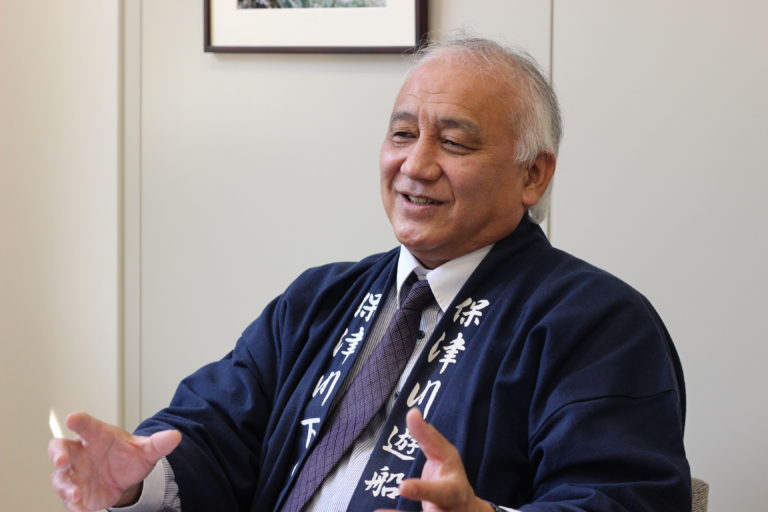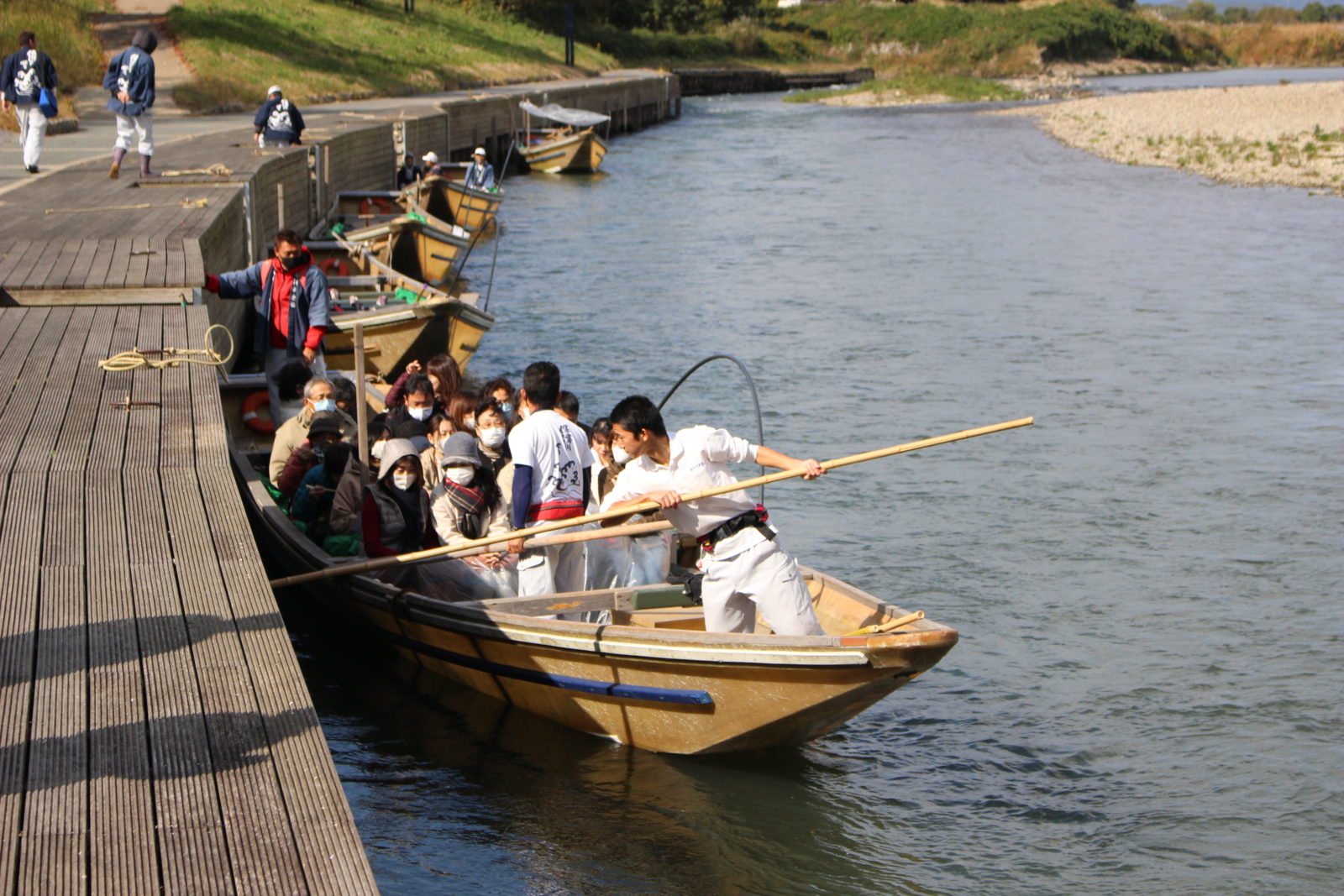The Reporter’s Dilemma
As a person who has always been full of curiosity, Toyota was always enamored with journalists. Before he began working with Hozugawayusen, he worked as a reporter.

“I wanted to know about the world, so I became a reporter. When you start listening to what people have to say, the deeper issues start to come to light. But with limited space on the page, I wasn’t able to fully explain the deeper issues at play. I wanted to write articles that could lead to real solutions, but couldn’t. It was a dilemma.”
After Japan’s economic bubble of the late eighties and early nineties burst, Toyota felt a great deal of stress due to the dispassionate way his job required him to report on the difficulties people were experiencing.
In the midst of all this, he happened upon the Hozu-gawa River Boat Ride.
“Seeing the way the boatmen confidently navigated down the river was so impressive. I couldn’t believe that this could be someone’s job. Meanwhile, in my own life, I was totally lost about my own career.”
After this experience, he quit his job as a reporter and began training to be a Hozu-gawa River Boat Ride boatman.

Occupation: Boatman
“Initially, I thought you just went along with the current; it looked easy. But when I tried it, it was pure hell.”
For the first year, it was so hard he couldn’t believe people did it for a living.

“In the beginning, your hands get torn up. But even though your skin is peeling off and you have blisters, you still have to pull the oar the next day.”
Due to the need to perform tasks that require dexterity from their hands, boatmen can’t wear gloves no matter how badly their hands are damaged. They have to “make their hands.” This is what the boatmen call the process of toughening their hands up.

A knowledge of the river currents as well as the teamwork between the three boatmen that steer the boat are important. It takes a full two years to learn all of the jobs a boatman must carry out.

“Since the boatmen work in three-man teams, a person new to the trade will have two teachers that carefully teach him the ins-and-outs of the job. They have to be aware of the new person’s character and quirks as they teach them.”

Project Hozugawa
“In 2012, researchers and officials from around the world gathered in Kameoka for three days to hold the ‘Marine Litter Summit,’” Toyota told us.
Toyota not only works for the Hozu-gawa River Boat Ride, but he also heads Project Hozugawa, an organization that seeks to eliminate litter from the oceans and rivers.
But… Kameoka is not near the ocean. Why would the Marine Litter Summit be held in such a place?

“The Marine Litter Summit was originally held in places located on the ocean. Those cities would do things such as working with fishermen to deal with the litter, but then the thinking shifted. People began to realize the fundamental problem wasn’t in the ocean – it was in the rivers.”
Toyota came to think of the problem this way from his experience working on the river as a boatman. From this perspective, he began to wonder if the marine litter problem wasn’t being caused by those of us who live inland.
So, he and some researchers and scientists created an NPO – Project Hozugawa – with Toyota as its point man.
Tracking the Path of Litter
The first order of business for Project Hozugawa was to do an experiment that would determine whether litter from the river was really making its way out into the ocean.
“We put some GPS devices in waterproof containers and let them go in the Hozu River. When the river’s water level was high, we found they reached Osaka Harbor in a day. Some went on as far as the Akashi Channel.”
This experiment proved beyond a doubt that litter from inland areas including the area around the Hozu River was making its way into the ocean.
“Ultimately, if we inlanders don’t properly grasp the litter problem before attempting to address it, we won’t be able to fundamentally solve it. So, that was the deeper meaning behind having the Marine Litter Summit here in inland Kameoka.”
Developing the “Litter Map” App
Project Hozugawa has also developed an app called “Litter Map.” Enlisting the cooperation of locals, they ask people to use the app to upload a picture of any trash they find.

“This app accumulates data on the type, amount, and location of litter.”
In order to get the cooperation of local residence associations, they have also held events that teach people how to use the app.
“Looking at the data accumulated in the app, we learned that plastic is the most abundant kind of litter. Once plastic makes its way out into the ocean, it’s not as easy to collect it. So, we want to get to it while it’s still in the river.”
In part thanks to Project Hozugawa’s efforts, Kameoka City made its Kameoka Zero Plastic Waste Declaration in 2018. Its stated goal is to eliminate disposable plastic trash by the year 2030.
Disposable Plastic Shopping Bags
Project Hozugawa was the first to call for the reduction of disposable plastic shopping bags.
That’s because most of the litter they see during river clean-up operations are old plastic bags.
“We aren’t saying don’t use plastic; we’re saying let’s stop using disposable plastic. Most plastic shopping bags are disposable and are given out far more than necessary.”
PET bottles and polystyrene trays are usually a part of the products you buy, so there’s no way around purchasing them sometimes. However, disposable plastic shopping bags could be done away with if everyone would just carry their own reusable bags.
After talks with interested parties, six supermarkets and some 54 businesses from the shopping arcades around the city agreed to start charging for their plastic bags in August, 2019.
Local Action Brings About Nationwide Results
In the beginning people often asked, “Why do this in a small place like Kameoka? Is there really any meaning?”
“It’s difficult for large organizations at the national level to quickly change their policies. We thought that the way to go about it was to start locally. If these changes started popping up everywhere at the local level, the changes would naturally come at the national level.”
This logic was borne out when Kameoka’s plastic shopping bag policy was noticed by the Ministry of the Environment and the Ministry of Economy, Trade and Industry. It led to a nationwide policy of charging for plastic shopping bags.
Project Hozugawa and Kameoka City will continue to promote the Kameoka Zero Plastic Waste Declaration in an effort to realize the goal of eliminating plastic waste by 2030.
“In addition to thinking about where to go next with the Hozu-gawa River Boat Ride, there are things I want to do for the region and local industry. No matter the difficulty, I want to keep working for positive change.”
Since his time as a reporter, Toyota felt there was a need for a person to turn plans into action in order to solve societal issues.

“The idea that everyday people are powerless to do anything about environmental problems due to the perceived costs involved is an outdated way of thinking. We boatmen working on the Hozu River would like to get this message out and hopefully improve the image of Kameoka overall in the process.”
This movement, started by a Hozu-gawa River Boat Ride boatman, has the potential to solve a great deal of environmental problems in Japan.
Kameoka asks for your support in its effort to become a city on the cutting-edge of environmental change.
And when you come to Kameoka City, be sure to appreciate the beautifully maintained river as you enjoy the Hozu-gawa River Boat Ride.


